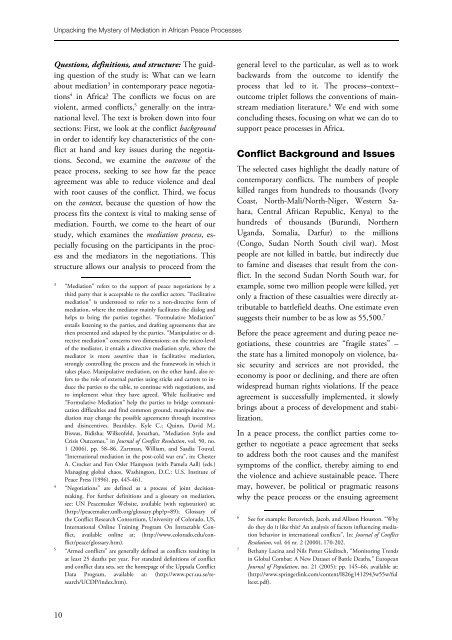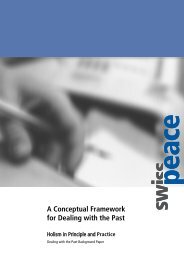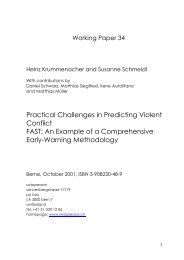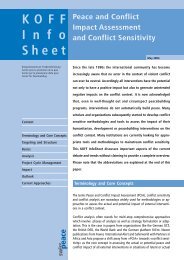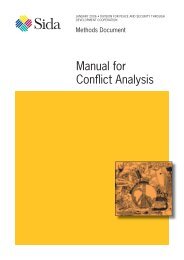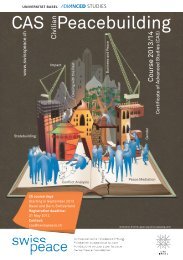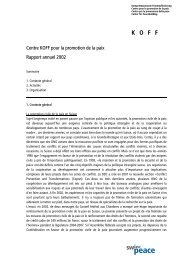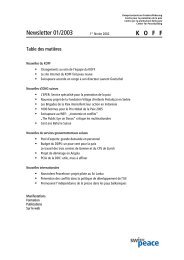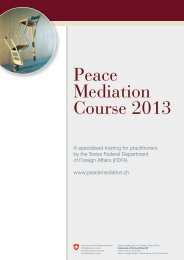Unpacking the Mystery of Mediation in African Peace ... - Swisspeace
Unpacking the Mystery of Mediation in African Peace ... - Swisspeace
Unpacking the Mystery of Mediation in African Peace ... - Swisspeace
Create successful ePaper yourself
Turn your PDF publications into a flip-book with our unique Google optimized e-Paper software.
<strong>Unpack<strong>in</strong>g</strong> <strong>the</strong> <strong>Mystery</strong> <strong>of</strong> <strong>Mediation</strong> <strong>in</strong> <strong>African</strong> <strong>Peace</strong> Processes<br />
Questions, def<strong>in</strong>itions, and structure: The guid<strong>in</strong>g<br />
question <strong>of</strong> <strong>the</strong> study is: What can we learn<br />
about mediation 3 <strong>in</strong> contemporary peace negotiations<br />
4 <strong>in</strong> Africa? The conflicts we focus on are<br />
violent, armed conflicts, 5 generally on <strong>the</strong> <strong>in</strong>tranational<br />
level. The text is broken down <strong>in</strong>to four<br />
sections: First, we look at <strong>the</strong> conflict background<br />
<strong>in</strong> order to identify key characteristics <strong>of</strong> <strong>the</strong> conflict<br />
at hand and key issues dur<strong>in</strong>g <strong>the</strong> negotiations.<br />
Second, we exam<strong>in</strong>e <strong>the</strong> outcome <strong>of</strong> <strong>the</strong><br />
peace process, seek<strong>in</strong>g to see how far <strong>the</strong> peace<br />
agreement was able to reduce violence and deal<br />
with root causes <strong>of</strong> <strong>the</strong> conflict. Third, we focus<br />
on <strong>the</strong> context, because <strong>the</strong> question <strong>of</strong> how <strong>the</strong><br />
process fits <strong>the</strong> context is vital to mak<strong>in</strong>g sense <strong>of</strong><br />
mediation. Fourth, we come to <strong>the</strong> heart <strong>of</strong> our<br />
study, which exam<strong>in</strong>es <strong>the</strong> mediation process, especially<br />
focus<strong>in</strong>g on <strong>the</strong> participants <strong>in</strong> <strong>the</strong> process<br />
and <strong>the</strong> mediators <strong>in</strong> <strong>the</strong> negotiations. This<br />
structure allows our analysis to proceed from <strong>the</strong><br />
3 “<strong>Mediation</strong>” refers to <strong>the</strong> support <strong>of</strong> peace negotiations by a<br />
third party that is acceptable to <strong>the</strong> conflict actors. “Facilitative<br />
mediation” is understood to refer to a non-directive form <strong>of</strong><br />
mediation, where <strong>the</strong> mediator ma<strong>in</strong>ly facilitates <strong>the</strong> dialog and<br />
helps to br<strong>in</strong>g <strong>the</strong> parties toge<strong>the</strong>r. “Formulative <strong>Mediation</strong>”<br />
entails listen<strong>in</strong>g to <strong>the</strong> parties, and draft<strong>in</strong>g agreements that are<br />
<strong>the</strong>n presented and adapted by <strong>the</strong> parties. “Manipulative or directive<br />
mediation” concerns two dimensions: on <strong>the</strong> micro-level<br />
<strong>of</strong> <strong>the</strong> mediator, it entails a directive mediation style, where <strong>the</strong><br />
mediator is more assertive than <strong>in</strong> facilitative mediation,<br />
strongly controll<strong>in</strong>g <strong>the</strong> process and <strong>the</strong> framework <strong>in</strong> which it<br />
takes place. Manipulative mediation, on <strong>the</strong> o<strong>the</strong>r hand, also refers<br />
to <strong>the</strong> role <strong>of</strong> external parties us<strong>in</strong>g sticks and carrots to <strong>in</strong>duce<br />
<strong>the</strong> parties to <strong>the</strong> table, to cont<strong>in</strong>ue with negotiations, and<br />
to implement what <strong>the</strong>y have agreed. While facilitative and<br />
“Formulative <strong>Mediation</strong>” help <strong>the</strong> parties to bridge communication<br />
difficulties and f<strong>in</strong>d common ground, manipulative mediation<br />
may change <strong>the</strong> possible agreements through <strong>in</strong>centives<br />
and dis<strong>in</strong>centives. Beardsley, Kyle C.; Qu<strong>in</strong>n, David M.;<br />
Biswas, Bidisha; Wilkenfeld, Jonathan, “<strong>Mediation</strong> Style and<br />
Crisis Outcomes,” <strong>in</strong> Journal <strong>of</strong> Conflict Resolution, vol. 50, no.<br />
1 (2006), pp. 58–86. Zartman, William, and Saadia Touval.<br />
“International mediation <strong>in</strong> <strong>the</strong> post-cold war era”, <strong>in</strong>: Chester<br />
A. Crocker and Fen Osler Hampson (with Pamela Aall) (eds.)<br />
Manag<strong>in</strong>g global chaos, Wash<strong>in</strong>gton, D.C.: U.S. Institute <strong>of</strong><br />
<strong>Peace</strong> Press (1996). pp. 445-461.<br />
4 “Negotiations” are def<strong>in</strong>ed as a process <strong>of</strong> jo<strong>in</strong>t decisionmak<strong>in</strong>g.<br />
For fur<strong>the</strong>r def<strong>in</strong>itions and a glossary on mediation,<br />
see: UN <strong>Peace</strong>maker Website, available (with registration) at:<br />
(http://peacemaker.unlb.org/glossary.php?p=89); Glossary <strong>of</strong><br />
<strong>the</strong> Conflict Research Consortium, University <strong>of</strong> Colorado, US,<br />
International Onl<strong>in</strong>e Tra<strong>in</strong><strong>in</strong>g Program On Intractable Conflict,<br />
available onl<strong>in</strong>e at: (http://www.colorado.edu/conflict/peace/glossary.htm).<br />
5 “Armed conflicts” are generally def<strong>in</strong>ed as conflicts result<strong>in</strong>g <strong>in</strong><br />
at least 25 deaths per year. For standard def<strong>in</strong>itions <strong>of</strong> conflict<br />
and conflict data sets, see <strong>the</strong> homepage <strong>of</strong> <strong>the</strong> Uppsala Conflict<br />
Data Program, available at: (http://www.pcr.uu.se/research/UCDP/<strong>in</strong>dex.htm).<br />
10<br />
general level to <strong>the</strong> particular, as well as to work<br />
backwards from <strong>the</strong> outcome to identify <strong>the</strong><br />
process that led to it. The process–context–<br />
outcome triplet follows <strong>the</strong> conventions <strong>of</strong> ma<strong>in</strong>stream<br />
mediation literature. 6 We end with some<br />
conclud<strong>in</strong>g <strong>the</strong>ses, focus<strong>in</strong>g on what we can do to<br />
support peace processes <strong>in</strong> Africa.<br />
Conflict Background and Issues<br />
The selected cases highlight <strong>the</strong> deadly nature <strong>of</strong><br />
contemporary conflicts. The numbers <strong>of</strong> people<br />
killed ranges from hundreds to thousands (Ivory<br />
Coast, North-Mali/North-Niger, Western Sahara,<br />
Central <strong>African</strong> Republic, Kenya) to <strong>the</strong><br />
hundreds <strong>of</strong> thousands (Burundi, Nor<strong>the</strong>rn<br />
Uganda, Somalia, Darfur) to <strong>the</strong> millions<br />
(Congo, Sudan North South civil war). Most<br />
people are not killed <strong>in</strong> battle, but <strong>in</strong>directly due<br />
to fam<strong>in</strong>e and diseases that result from <strong>the</strong> conflict.<br />
In <strong>the</strong> second Sudan North South war, for<br />
example, some two million people were killed, yet<br />
only a fraction <strong>of</strong> <strong>the</strong>se casualties were directly attributable<br />
to battlefield deaths. One estimate even<br />
suggests <strong>the</strong>ir number to be as low as 55,500. 7<br />
Before <strong>the</strong> peace agreement and dur<strong>in</strong>g peace negotiations,<br />
<strong>the</strong>se countries are “fragile states” –<br />
<strong>the</strong> state has a limited monopoly on violence, basic<br />
security and services are not provided, <strong>the</strong><br />
economy is poor or decl<strong>in</strong><strong>in</strong>g, and <strong>the</strong>re are <strong>of</strong>ten<br />
widespread human rights violations. If <strong>the</strong> peace<br />
agreement is successfully implemented, it slowly<br />
br<strong>in</strong>gs about a process <strong>of</strong> development and stabilization.<br />
In a peace process, <strong>the</strong> conflict parties come toge<strong>the</strong>r<br />
to negotiate a peace agreement that seeks<br />
to address both <strong>the</strong> root causes and <strong>the</strong> manifest<br />
symptoms <strong>of</strong> <strong>the</strong> conflict, <strong>the</strong>reby aim<strong>in</strong>g to end<br />
<strong>the</strong> violence and achieve susta<strong>in</strong>able peace. There<br />
may, however, be political or pragmatic reasons<br />
why <strong>the</strong> peace process or <strong>the</strong> ensu<strong>in</strong>g agreement<br />
6 See for example: Bercovitch, Jacob, and Allison Houston. “Why<br />
do <strong>the</strong>y do it like this? An analysis <strong>of</strong> factors <strong>in</strong>fluenc<strong>in</strong>g mediation<br />
behavior <strong>in</strong> <strong>in</strong>ternational conflicts”, In: Journal <strong>of</strong> Conflict<br />
Resolution, vol. 44 nr. 2 (2000), 170-202.<br />
7 Bethany Lac<strong>in</strong>a and Nils Petter Gleditsch, “Monitor<strong>in</strong>g Trends<br />
<strong>in</strong> Global Combat: A New Dataset <strong>of</strong> Battle Deaths,” European<br />
Journal <strong>of</strong> Population, no. 21 (2005): pp. 145–66, available at:<br />
(http://www.spr<strong>in</strong>gerl<strong>in</strong>k.com/content/l826g1412943w55w/ful<br />
ltext.pdf).


